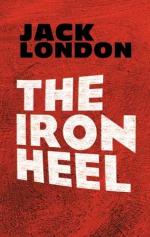“I have demonstrated to you mathematically the inevitable breakdown of the capitalist system. When every country stands with an unconsumed and unsalable surplus on its hands, the capitalist system will break down under the terrific structure of profits that it itself has reared. And in that day there won’t be any destruction of the machines. The struggle then will be for the ownership of the machines. If labor wins, your way will be easy. The United States, and the whole world for that matter, will enter upon a new and tremendous era. Instead of being crushed by the machines, life will be made fairer, and happier, and nobler by them. You of the destroyed middle class, along with labor—there will be nothing but labor then; so you, and all the rest of labor, will participate in the equitable distribution of the products of the wonderful machines. And we, all of us, will make new and more wonderful machines. And there won’t be any unconsumed surplus, because there won’t be any profits.”
“But suppose the trusts win in this battle over the ownership of the machines and the world?” Mr. Kowalt asked.
“Then,” Ernest answered, “you, and labor, and all of us, will be crushed under the iron heel of a despotism as relentless and terrible as any despotism that has blackened the pages of the history of man. That will be a good name for that despotism, the Iron Heel."*
* The earliest known
use of that name to designate the
Oligarchy.
There was a long pause, and every man at the table meditated in ways unwonted and profound.
“But this socialism of yours is a dream,” Mr. Calvin said; and repeated, “a dream.”
“I’ll show you something that isn’t a dream, then,” Ernest answered. “And that something I shall call the Oligarchy. You call it the Plutocracy. We both mean the same thing, the large capitalists or the trusts. Let us see where the power lies today. And in order to do so, let us apportion society into its class divisions.
“There are three big classes in society. First comes the Plutocracy, which is composed of wealthy bankers, railway magnates, corporation directors, and trust magnates. Second, is the middle class, your class, gentlemen, which is composed of farmers, merchants, small manufacturers, and professional men. And third and last comes my class, the proletariat, which is composed of the wage-workers.*
* This division of society made by Everhard is in accordance with that made by Lucien Sanial, one of the statistical authorities of that time. His calculation of the membership of these divisions by occupation, from the United States Census of 1900, is as follows: Plutocratic class, 250,251; Middle class, 8,429,845; and Proletariat class, 20,393,137.
“You cannot but grant that the ownership of wealth constitutes essential power in the United States to-day. How is this wealth owned by these three




